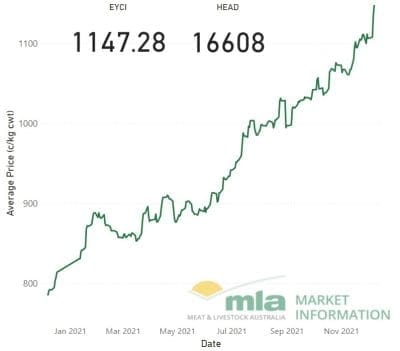THE impact of widespread rain is the latest contributor to the rampant rise in the Eastern Young Cattle Indictor, which now threatens to push through an unheralded 1150c/kg in coming days.
Yesterday’s indicator reached a new record high of 1147.28c – again, driven hard by large yardings of high-priced eligible yearling and vealer cattle at Queensland’s Dalby (Wednesday) and Roma (Tuesday) store sales.
The EYCI rose another 12c since Tuesday, and 40c/kg over the past week. This time last year, the indicator was more than 355c/kg behind where it currently sits.
In a gradual shift seen since the start of spring, yearling-weight steers and heifers now dominate the contributions to the indicator, accounting for 57pc of this week’s total of EYCI-eligible cattle, of a fraction over 16,600 head. Yearling heifers sold over the past week accounted for another 34pc, leaving just 9pc for vealer-weight steers and heifers.
Roma accounted for almost 16pc of yesterday’s indicator figure, averaging a record 1261.78c/kg for eligible steers and heifers, while Dalby accounted for 15.4pc of the total, averaging more than 1193c. Also making a significant return contribution this week was Gunnedah, accounting for 1664 head or 10pc of the indicator calculation’s total – having missed its previous two sales due to flooding.
Four sales held in the past week have averaged north of 1200c for eligible yearlings and vealers, including Singleton, Casino, Scone and Roma.
While there is an underlying belief that larger numbers of heifers are being retained this year for herd-rebuilding, throughput of EYCI eligible cattle for the 2021 year to 30 November was only down 1pc on the same period last year, NLRS records show.
The EYCI first broke through 1100c on November 17, preceding the latest widespread rain event, and hit 1000c/kg for the first time back on 23 July.
The EYCI is a seven-day rolling average of vealer and yearling steers and heifers +200kg sold in 23 saleyards across Queensland, NSW and Victoria. The indicator is expressed in c/kg carcase weight. Results are weighted by turnover in each selling centre.
MLA’s market information manager Stephen Bignell said recent weather across eastern Australia was definitely contributing to the EYCI’s current performance.
“Interestingly, there has been a huge increase in the number of EYCI-eligible cattle being sold, at the same time as the latest sharp increase in price,” Mr Bignell said.
“Under conventional economic principles, a rise in numbers like this would put downwards pressure on price – but the current result clearly illustrates that this is demand driven, and latest rain has helped that.”
The past seven days has seen turnover of EYCI-eligible cattle across the three eastern states reach a little over 16,600 head, compared with only 10,000 at the end of November.
Top of the price cycle close?
Mr Bignell said reasons for the current jump in turnover were not easy to pin down, but some had speculated that it might be vendors suspecting that the market was now very close to the top of the cycle, wanting to cash-in before a slide occurs.
Some have suggested that movement could possibly be precipitated by upcoming saleyards Christmas holiday closures.
The growing strength of Queensland restockers in the EYCI eligible cattle turnover in the past week was reflected in the market strength seen at Dalby and Roma this week. As of yesterday, 37pc of EYCI saleyards cattle were being bought by restockers, up from 30pc at the end of last week.
Mr Bignell said there was a clear trend in restocker demand starting to shift north, into Queensland and northern NSW, where previously it was deeper into NSW.
Lotfeeders, also, are now dominating the EYCI market, accounting for 57pc of all sales in the past week. And feeders, typically taking the heavier end of the EYCI-eligible cattle, are themselves paying very close to 1100c/kg dressed weight equivalent for purchases – a record high.
“Because feeders are now taking the largest share of the EYCI yardings, and are paying a record high just short of 1100c for their purchases, that is also serving to drive up the overall EYCI number to all-time record highs,” Mr Bignell said.
“It’s no longer just about restockers.”
Asked whether the prospect of abundant, and potentially cheaper feedgrains caused by weather downgrades on wheat had motivated lotfeeders to bid even higher on feeder replacements, Mr Bignell said NLRS had heard comments to that effect.
The EYCI officially closes for the year after sales next Thursday, December 16 (no sales are held on Friday), resuming for the new year on 12 January 2022, picking up some of the big weaner sales in the south.

